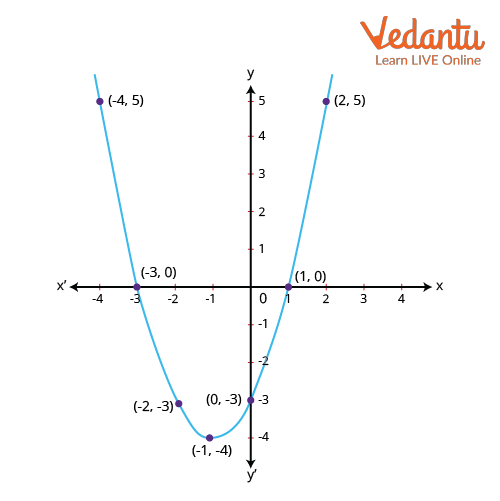




What is a Quadratic Polynomial?
A polynomial is any expression in mathematics that has one or more algebraic terms along with numerical values. A polynomial function can comprise completely of variable terms as well. A few examples of polynomial functions will be the quadratic and cubic functions. Even a linear function in the form of y = mx+ x will be considered a linear polynomial whose graph is a straight line.
A quadratic polynomial is a mathematical expression where the highest power or degree of the variables is 2. Quadratic polynomials trace a different curve when plotted and graphed on the sheet. The graph of a quadratic polynomial is a parabola. Depending on the values of the coefficients in the expression and the discriminant, we get either a parabola opening upwards or downwards when x is the independent variable. Again, if the quadratic expression is in terms of y where the x is the dependable variable, the parabola will open either towards the right or towards the left.
Graph of Quadratic Polynomial
As mentioned before, the quadratic polynomial graph is a parabola. If the polynomial function has x as the independent variable, then the roots of the quadratic expression give us the points where the graph cuts the x-axis. Similarly, if the quadratic function is in terms of y as the independent variable, then the roots of the function will give us the point of intersection of the y-axis and the parabolic curve.
To draw the graph of a quadratic polynomial we must follow the steps given below:
Let the given polynomial by
Next, we write the given quadratic function as a y that is
The third step is to calculate the zeroes of the quadratic polynomial by equation y to 0. This goes as follows:
To get the points where the parabolic curve meets the y axis, we replace x with 0.
Lastly we calculate the value of the discriminant of the quadratic function that is given by
When D > 0, the graph intersects the x-axis at two distinct points which are given by the roots of the functions
When D = 0, the parabolic graph touches the x-axis at one single point.
When D < 0, the graph does not touch the axis and lies far away.
The last step is to find the turning point of the curve which has the coordinates
For drawing on the graph, we must plot the x values and their corresponding y values. By plotting these points on the graph we can easily draw the graph of a quadratic polynomial. If the value of the coefficient of the squared x term i.e. a > 0 then the parabola opens upwards. If a <0 the parabola will open downwards
To understand this further, we take the following quadratic polynomial example:
Example: Let the given quadratic polynomial function be
Solution:
To solve this example we will follow the exact steps mentioned above.
Let
Since a > 0, the parabola will open upwards.
Next, we calculate the discriminant,
As we can see D > 0. Therefore the parabola will intersect the x-axis at two distinct points which will give us the roots of the quadratic polynomial.
Equation y and 0, we get
Simplifying we get,
From the above expression we can find out the roots of the given quadratic function to be 1 and -3. i.e. either x = 1 or x = (-3)
Thus the graph intersects the x-axis at points ( 1 ,0 ) and ( -3,0 ).
The vertex of the parabola is given by
The required polynomial chart to draw the graph will be given as follows:
Required Table
Image 1: Table showing the x and y values for
Therefore the required graph that we obtain from plotting all the points is as follows:

Parabolic Graph of
Relationship Between Zeros of a Quadratic Polynomial and its Roots
Let us consider the quadratic polynomial,
Therefore,
Thus comparing the coefficients of the terms of the quadratic function we get,
Therefore the sum of the zeroes is given by
Conclusion
A quadratic polynomial is any mathematical expression constituting numerical coefficients and variables. The highest degree of power of the variable in this context is 2. The graph of a quadratic polynomial is a parabola. If the coefficient of the x2 term is positive then the parabola will open upwards. If the coefficient of the x2 term is less than 0, then the parabola opens upwards. The value of the discriminant gives us the position of the curve on the graph. When D= 0 the graph intersects the x-axis and at D > 0 and D < 0, the curve touches the axis at a single point and lies above the axis, respectively. The relations between the roots of a quadratic polynomial and its roots are given as follows:
FAQs on Graph of a Quadratic Polynomial for JEE
1. What is the relationship between roots and zeros of a cubic function? What is the definition of a cubic polynomial's zeros?
Just as we see in the case of quadratic equation, the relationship between the roots and zeros is given as follows:
The cubic polynomial has the form
2. What is the meaning of the term "quadratic equation"? How can you decide whether a graph is quadratic or not?
In mathematics, a quadratic problem is one in which a variable is multiplied by itself, which is known as squares. The size of a square is equal to its side length multiplied by itself in this language. The word "quadratic" comes from the Latin word quadratum, which means "square."The easiest way to see whether the graph is that of a quadratic function or not, we simply need to check the curve. A quadratic function always exhibits a parabolic curve.
Thus, we can simply check whether the shape traced is a parabola or not to check whether the function is quadratic in nature or not.
























